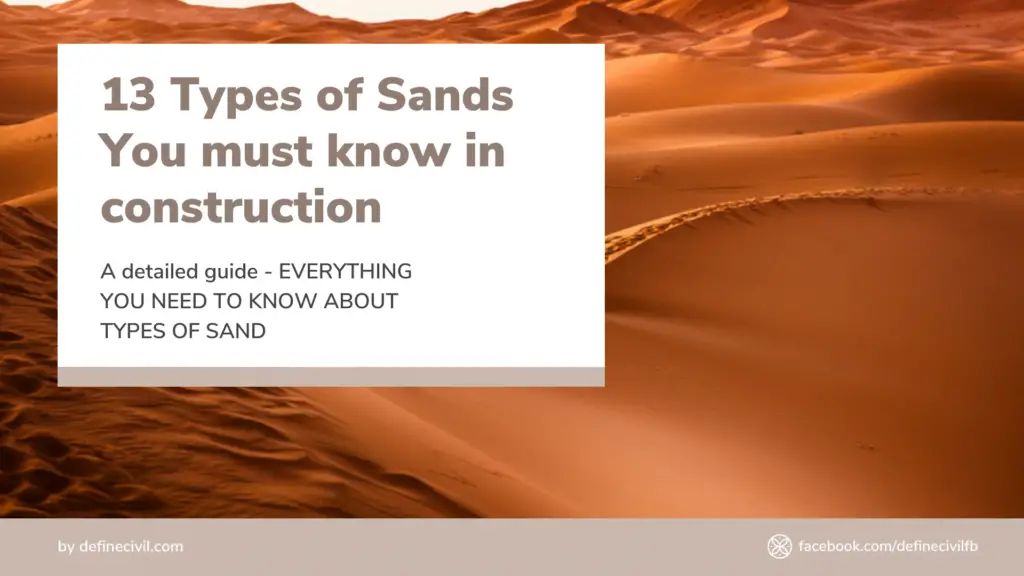With so many types of sands in the market, you can’t randomly pick one for your project. Depending on the color, size, and source; the sand can show different properties that are critical for your project. So, in order to get the best result, try to know your options and choose a type of sand that goes well with your budget.
Based on color, sand comes in many different shades and hues, from sandy brown to silvery gray to golden yellow and beyond. But what’s the best sand color to use in your home building or landscaping project? And how can you tell one type of sand from another?
Here are eight different types of sand, where they come from, and the best ways to use them:
Types of Sand based on Color
Most sand is whitish grey, but not all. There’re red, light brown, and even pink color sands available in market that’s more than just decorative. So, understanding the purpose of sand colors can be helpful for knowing what you’re buying when ordering materials for your next building project.
For example, for sand in patio with wooden furniture, you’ll want to avoid sands with metal pigments—as it will look odd. So before you order any type of sand based on color, make sure you know the purpose and the outcome.

Here are some common colored sands:
Black Sand
Some regions have all black sand. It comes from volcanoes or fires, depending on where you are. The only real benefit here is for cleanliness, but it is also very abrasive on your machines. So, if you work with machinery to make something be ready for the damage to your equipment. Some other applications of black sand are in concrete, plastics, rubber, cosmetics, and painting industries.
When mixed with other types of sand it can lower grain size because it will pack together tightly while other grains do not pack together tightly.
White Sand
The white sand can be found in almost any large construction project and is also named as silica sand. This sand is typically classified as quartz sand, which is great for filling large holes or for adding strength in support beams.
It is also great for leveling uneven flooring surfaces, but tends to show up more often in projects that are designed with aesthetics in mind over function (think: a sandy beach). White sand can be found anywhere where quartz is found at a source near you.
Also Read: Rapid Sand Filters – Working – Components – Everything Explained
Grey / Greywacke Sand
This sand, which is available in almost every city, is used in concrete, roads and mortar. It comes from various mines throughout most states.
Depending on where you get it from, it can have a variety of metal elements that might or might not be harmful to your project. Look for grey color sand based on where it was mined as well as its chemical makeup before you decide whether or not to use it.
Grey sand, depending on the size, works best for plastering, brickwork, and reinforced concrete elements. This type of sand offers better grain shape with smooth texture. Since water is trapped in the particles, so for mixing it needs less amount of water.
Pink Sand
This kind of sand is often used in concrete mixes. It’s called pink because it resembles pink quartz and has a reddish tint when wet.
Pink sand is also known as coral sand. It is used for projects that have a beach or underwater feel. It has a fine texture and does not stain easily. Pink sand is commonly found in Caribbean countries, including Barbados, Jamaica, St. Martin, Aruba, Trinidad & Tobago and Grenada.
Type of sand based on Size
The type of sand you choose will also be based on its size and is commonly three types of sand. Silica sand is great for mixing with concrete because it’s smaller than river sand and easier to work with. It won’t get caught in your concrete mixer, either.
However, if you’re using silica sand in its natural state (as a sub-base material beneath a patio or walkway), it’s not recommended. Why? Because when dry, it’s hard as rock—but once wet, it becomes too mushy for use as an outdoor base material. If that’s what you need, stick with river or construction sand.
We classify sand based on sizes as per the ASTM Classification as fine, moderate coarse, or coarser sand. Let’s see some type of sands based on sizes:
Fine Sand
Fine sand offers smooth finishing and hence is best for rendering, plastering, or screeding in construction. You can use fine sand to fill sandbags or backfill any area as it delivers higher density. Anyhow, you can’t use this sand in construction for concrete purpose. If you use it in concrete, there will be increased demand of water that will eventually result in shrinkage cracks or other deteriorations.
River sand is also referred to as fine sand. However, river sand does have water in its voids and can be used for plastering, RCC, and several other blocks work.
For standard ASTM sieves, we can classify sand as “fine” if it passes through 16 number (1.19 mm or 0.0469 inches) standard sieve.
Moderate-coarse sand
Medium-grain sand is used for concrete, mortar and stucco. This type of sand has a relatively smooth surface, which helps it to bind well with clay, cement or other materials in these projects. It’s also considered an ideal size for filling drywall joint compounds.
Because medium-grain sand is small but not too fine—and even, because it adheres well without sticking together—it’s a popular building material for many types of construction projects.
Coarse Sand
Based on size, coarse-size sand is larger than fine-sieve sand. Typically sized at .25 mm or larger, it’s often used for pathways, driveways and playgrounds. Due to its large size, however, it has a tendency to slip through standard screens if you’re creating mortar for brickwork.
Types of sand based on source
River / Sea Beach Sands
Due to its smooth consistency, river sand is used in mortar mixes or plaster type of sand around the world. You can find it in most hardware stores. It may look slightly grayish, but there shouldn’t be any other colors mixed in. If you see rocks or mud mixed in with your sand, don’t buy it; they don’t play well with others.
Being a natural material, it is readily available for number of construction projects. It can be obtained from river banks and streams. It offers extremely high quality finish with smooth texture. Due to better shape of grains, it is one of the most widely used sand in construction.
The river or sea beach sands are rich in water and don’t demand much water. The moisture is already entrapped in the voids with 5 to 20% of silt content in them. It is cheaper and have silica content in them. However, you must confirm that the sand type has silica content less than 5%.
Pit Sand
Pit sand comes from rock excavated from pits and quarries (hence its name). It is larger in size and is obtained by crushing to required size. In construction, we rely on pit sand where there are no rivers or streams nearby to use. Due to different sources, the color of the pit sand can vary.
It is best used for construction of buildings as it delivers the best binding property. Naturally, pit sand has rough, sharp, angular, and coarse grains that are well-known for excellent binding properties. Due to presence of iron oxide, it can give hue of red-orange.
Manufactured Sand
These are made by crushing rocks, such as limestone or granite. Manufactured Sand or M-sand tend to be more expensive than natural sand but are also stronger. Manufactured sand is great for making concrete, as well as in landscaping projects.
Manufactured sand can have a range of colors due to its source material; sometimes they come from special processes that leave behind a different color than what you’d find naturally.
Fill Sand
All sand is not created equal. Fill sand, also known as construction sand, is made from crushed minerals found in granite or quartz rocks. It’s generally used to fill areas where land has been dug up during building projects.
For example, if a section of a yard has been excavated to create a swimming pool, fill sand would be used as an additive to help level out that area of land so new grass can grow there.
FAQs
What is sand in civil engineering?
Sand in civil engineering is a mix of small grains or particles of rock or granular material. It is finer than gravel or aggregate but is coarser than silt. The particle size of sand ranges from 0.06 mm to 2mm. Sand is used in civil engineering construction projects from asphalt, concrete, mortar, scree, and rendering to filling, roofing, grouting, and painting.
What are the three types of sand?
Based on source, sand comes in three varieties: natural, dredged or manufactured. Natural sand is obtained from a natural environment such as riverbeds or beaches. Dredged sand is material created from excavation efforts. Manufactured sand is derived from crushed rock that’s been processed for its desired use.
How is sand classified?
The ASTM standard is used primarily in construction projects to classify sand. The particular classifications are based on particle size: coarse, medium and fine. Coarse sands are created from what are called gravel-sized rocks that range from 1/4 inch (0.64 centimeter) to 2 inches (5 centimeters). This type of sand is ideal for building concrete foundations as well as masonry walls because it does not compress easily.

















